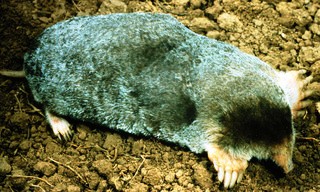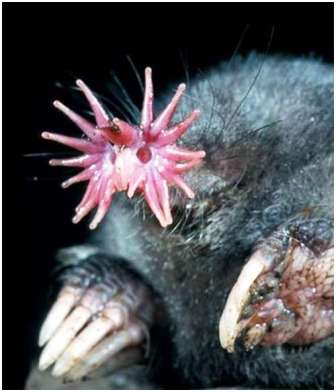Discover Florida Nature
It's time to explore the natural Florida


|
|
|
|
|
 Eastern
Mole- Eastern Moles are small mammals which are rarely seen.
They are most active at dawn and dusk, when it is difficult to see them;
but that doesn't matter, because they spend almost all of their time
underground. Eastern Moles have short grayish-brown fur with large front
feet. The toes on their feet are slightly webbed. The eastern mole has
an average total length of 5½-6 inches and a short, sparsely haired tail
1-1½ inches long. They have a long, naked snout. You will not see eyes
or ears on this animal. They do have very small eyes which are covered
by skin and fur. Moles have poor eyesight and probably only are able to
detect light with their eyes. The Eastern Mole occurs commonly through
out the state of Florida. Eastern
Mole- Eastern Moles are small mammals which are rarely seen.
They are most active at dawn and dusk, when it is difficult to see them;
but that doesn't matter, because they spend almost all of their time
underground. Eastern Moles have short grayish-brown fur with large front
feet. The toes on their feet are slightly webbed. The eastern mole has
an average total length of 5½-6 inches and a short, sparsely haired tail
1-1½ inches long. They have a long, naked snout. You will not see eyes
or ears on this animal. They do have very small eyes which are covered
by skin and fur. Moles have poor eyesight and probably only are able to
detect light with their eyes. The Eastern Mole occurs commonly through
out the state of Florida.Eastern Moles live in woods, fields, lawns, and gardens. They make burrows and tunnels to get around underground. The mole uses its strong front legs to push soil under its body. Then it uses its back legs to push the dirt behind its body. They are very good at this and can move much faster than you would think. Moles build a nest burrow and several main tunnels branching off of it. These are fairly deep underground. Mole tunnels are sometimes used by other animals, especially voles and mice. Tall weeds and grasses can help disguise mole holes and ridges and therefore offer some protection. The foods that moles are searching for include: earthworms, insects (adults and larvae), snails, centipedes, spiders, and other small creatures. They will sometimes eat mice or baby birds, if they find them. While moles do sometimes come above the surface, it is usually not for long. Sometimes they wait by a hole, ready to grab food or run back down if they see a threat. If a predator does come, and the mole cannot get underground, it will release a musk, which is a bad-smelling odor, to try to change the predator's mind. Eastern Moles have few predators, because they are not easy to catch. Snakes, foxes, raccoons, and owls will eat them if they can catch them. Moles do not hibernate. Because their burrows are usually below the frost, they stay active in Winter. Eastern Moles mate from February to March. Female moles have one litter a year, with two to five young. Nests are built with grasses, leaves, and plant parts in a burrow underneath a log, stump, or boulder. Eastern Moles usually live about three years.  Star
Nosed Mole- The Star-nosed Mole lives in wet lowland areas and
eats small invertebrates, aquatic insects, worms and mollusks. It is a
good swimmer and can forage along the bottoms of streams and ponds. Like
other moles, this animal digs shallow surface tunnels for foraging;
often, these tunnels exit underwater. The incredibly sensitive nasal
tentacles are covered with almost one hundred thousand minute touch
receptors known as Eimer’s organs. The star-nosed mole, Condylura
cristata, has been collected in the Okefenokee Swamp in Georgia and
has been reported in Florida. Star
Nosed Mole- The Star-nosed Mole lives in wet lowland areas and
eats small invertebrates, aquatic insects, worms and mollusks. It is a
good swimmer and can forage along the bottoms of streams and ponds. Like
other moles, this animal digs shallow surface tunnels for foraging;
often, these tunnels exit underwater. The incredibly sensitive nasal
tentacles are covered with almost one hundred thousand minute touch
receptors known as Eimer’s organs. The star-nosed mole, Condylura
cristata, has been collected in the Okefenokee Swamp in Georgia and
has been reported in Florida.As its name implies, the star-nosed mole has a very unusual snout, ringed with 11 pairs of pink appendages that form a fleshy star. There have been a lot of different ideas about the function of this distinctive feature. Some have proposed that it is a super-sensitive olfactory organ that helps the nearly blind moles to sniff there way around underground. Others have suggested that serves as an extra "hand" for grasping prey or other objects. Still others have argued that it serves as an antenna that detects electric fields as the moles swim through muddy marsh water. Like other moles, the star nosed mole ekes out an existence in a network of narrow underground tunnels, and digs shallow surface tunnels where it forages for insects, worms and mollusks. Living as it does in almost complete darkness, the star-nosed mole has poorly developed eyes, and is virtually blind. Instead, it relies heavily on its remarkable star-shaped nose. This organ enables the star-nosed mole to decide whether something is edible with astonishing speed - in fact, it recently entered the Guinness Book of Records as the world's fastest forager - and also to sniff out food underwater. When the Star-nosed Mole forages in the muck near its main burrows, presumably after earthworms, its favorite food, its tentacles are constantly in motion. When it eats, however, they are clumped together out of the way. An adept diver and swimmer, this mole also eats many aquatic animals, including fish. It propels itself in water, even under ice, by moving its feet and tail in unison. |
|
|
Advertise | Privacy Statement | Dog Encyclopedia | Video |Contact | Alaska Nature |
|